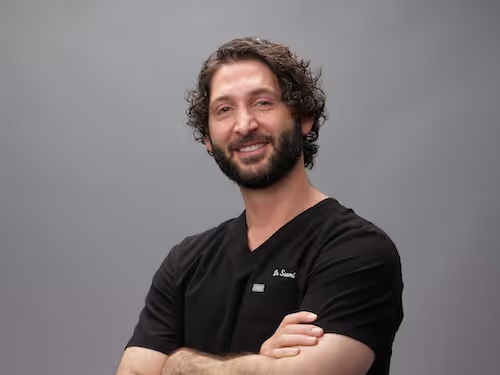What is Ozempic Face?: GLP-1 and Skin Changes
Combat Ozempic face with expert treatments for GLP-1 users. Learn how fillers, biostimulators, and skin tightening address volume loss and skin laxity from rapid weight loss. Schedule your consultation at SOM Aesthetics.
.avif)
We've heard a lot in the media about Ozempic and other GLP-1 drugs causing changes to the user's skin. Have you seen changes in GLP-1 users' skin in your practice? What kind of changes have you seen?
We’ve certainly noticed the skin changes associated with GLP-1 usage in my practice. As patients lose weight—especially rapidly—they tend to experience hollowing in areas such as the anterior face, under-eye area, and jowls (also known as Ozempic face), along with increased laxity in the neck, arms, and abdomen. These changes can result in volume loss and decreased skin quality, which can contribute to a more aged appearance. Patients can lose skin radiance, causing the skin to appear more dull and lackluster. However it is mostly a hollowed out or gaunt appearance that patients experience and this is due to decreased volume that affects both the superficial and deep fat pads of the face, and sometimes also causes some muscle atrophy.
How do you help patients avoid Ozempic face?
When a patient is using GLP-1 medications, we take extra care to customize their aesthetic treatment plan to address the rapid changes in volume loss and skin laxity. Together, we determine whether they prefer to address the changes as they occur or wait until they’ve reached their goal weight.
In either case, our goal is to reposition the tissue superiorly and laterally, and volumize using a multi-modal and multi-layered approach to pull the skin laterally and restore a more youthful structure. We focus on volumization with fillers to restore fullness, while using biostimulators like Sculptra or hyperdilute Radiesse to improve skin quality and elasticity. Skin-tightening treatments, such as BBL SkinTyte and SylfirmX Radiofrequency Microneedling, are also essential to firm and tighten the skin effectively. We can also use injectables like Renuva, which is decellularized adipose matrices, to help volumize those deflated facial fat pads thereby addressing the root cause of the hollowing, and customizing patients treatment plans to their areas of greatest need. This multi-layered approach addresses everything from ski, to superficial and deep fat, and sometimes even bone depending on the patients need. Renuva is a great option for GLP-1 patients since that is where they have often lost the majority of their facial volume.
Has a patient's use of GLP-1 impacted how or what you recommend for their at-home skin-care plan?
GLP-1 usage can certainly influence at-home skincare routines, but it’s important to note that with increased skin laxity and hollowing, topicals alone won’t suffice in restoring structure and volume. I recommend medical-grade skincare for hydration and maintenance, and I also emphasize the importance of nutritional supplementation, especially for patients undergoing biostimulator treatments. Adequate intake of branched-chain amino acids (BCAA) and vitamins can support skin quality and help maintain the effects of treatments like biostimulators.
What types of products, tools or skin-care ingredients do you predict patients using a GLP-1 drug needing in their weight loss journey?
Patients using GLP-1 drugs will need products that focus on improving skin quality and hydration, as well as tools that promote skin tightening. Given the hollowing and laxity associated with rapid weight loss, collagen- and elastin-stimulating products—like those containing retinoids, peptides, and antioxidants—will be essential. However, more advanced in-office treatments like fillers, biostimulators, and energy-based devices such as Sylfirm RF will play a pivotal role in addressing the structural changes caused by GLP-1 use.
How can the skin-care industry better support consumers who are using GLP-1 drugs while formulating new product and product categories?
The skincare industry has a unique opportunity to better serve consumers on GLP-1 medications by developing products that target skin tightening and elasticity improvement—key areas impacted by weight loss. The industry could also focus on creating formulations that work in harmony with in-office treatments like fillers and biostimulators. Additionally, supplements designed to support skin biostimulation from within—containing ingredients like collagen peptides, BCAA, and essential vitamins—can complement and enhance the results of aesthetic procedures.
What else about this topic do you think our beauty industry business reader should know about?
It’s crucial to understand that topicals alone won’t suffice for restoring significant volume loss or addressing skin laxity in patients using GLP-1 medications. Advanced aesthetic treatments such as fillers, biostimulators, and skin-tightening devices are necessary to effectively treat these concerns. There’s also an opportunity for the beauty industry to innovate by developing skincare products and supplements that complement in-office treatments, providing a holistic approach to maintaining a youthful, balanced appearance during weight loss.
For personalized recommendations, schedule a consultation at SOM Aesthetics to learn how the HALO laser can revitalize your complexion.
For more information on Ozempic face and other skin side effects of GLP-1 usage, check out this study from the National Institute of Health.



.svg)









